They Can Take It, But Not Dish It Out: Toughness and Magic 2014 (Part Two)
by: CML
4. From the Window to the Wall
Last week, I presented these ideas:
–Magic history is biased towards creatures with greater toughness than power (1,183 with power > toughness, and 1,587 with toughness > power, for a ratio of .745).
-New World Order has put the focus of MtG on the combat step, and good attacks can’t happen when your guys just bounce off each other, so I expected that ratio to be trending closer to one. This was true in sets like Alara Reborn and Modern Masters.
-But in recent sets, such as Gatecrash and Dragon’s Maze, the ratio has been less than the historical .745. This is taken the furthest in Magic 2014, where there are 16 power > toughness creatures and 27 toughness > power dudes, for a ratio of .593. (This analysis doesn’t take into account the cards’ rarity, or “as-fan” in R&D lingo.)
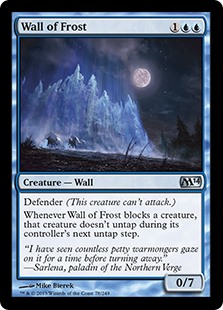
“I’d say it’s a little … underpowered.”
Now I want to explore how having more “tough” creatures affects the Limited format, and consider the implications for set design and cube design.
5. The Walls Are Closing In On Me
As Gatecrash shows, the set’s power to toughness ratio alone cannot predict how a format’s combat step will feel: that set had a low ratio, and yet it was a very fast format. However, my playgroup’s observations about M14 Limited all fall into place when you consider its own ratio of .593:
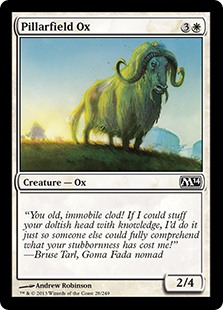
“How now, purple cow?”
-One of our more casual players said: “In M14 it just feels like every game results in a bunch of Giant Spiders and Pillarfield Oxen staring each other down, until somebody finally draws their 4/4.” This kind of design results in board states that are superficially complicated, but where there are no good attacks — a metaphor for how Magic can be a frustrating game, and a recipe for low player turnout. M14 has not sold well.
-The same casual-competitive player has echoed Ben Stark et al. in praising Regathan Firecat, and its ability to force trades with its 4 power and 1 toughness must be why. (In his excellent piece on SCG, Sam Black identifies the vanilla 4/1 as an archetype unto itself!)
-Though M14 isn’t all that rich in bombs (compared to, say, Scars of Mirrodin), the games end up going long enough that the bombs will always make an appearance. This kind of design invalidates not only the play decisions, of which there are few, but the drafting decisions too. Just take the bomb.
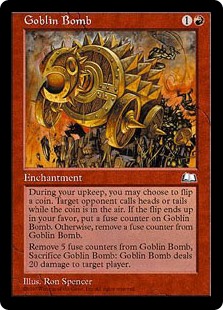
“Someone set us up …”
-Another way to break through these board stalls is to play auras. (I hate enchantments — they’re the least-interactive card type — and the rise of Standard Hexproof and the branding of Theros as an enchantment block both vex me). Buffing auras (and “all-upside mechanics” like Soulbond) are especially problematic in that they make WotC reluctant to print removal. Sadly, M14 validates this parsimony, as it has an absurd amount of all-purpose removal — making “bad” auras like Illusionary Armor a necessary gamble, but one that rarely pays off.
-The dearth of removal was quite fatal to Avacyn Restored and Magic 2012. M14 has the opposite problem. The overabundance of removal makes M14 play more like Scars of Mirrodin block, NWO’s other notable failure, and not Innistrad, Magic 2013, or Rise of the Eldrazi, its biggest successes. Stocking a set with both removal and powerful creatures is the New-World-Order way of creating a tense and dynamic game. (For an alternative, imagine Rise with all the Artisan of Kozilek and Ulamog’s Crusher, but no Guard Duty or Narcolepsy — that’s AVR or M12. Now imagine it with Guard Duty and Narcolepsy, but no efficient beaters — that’s M14.)
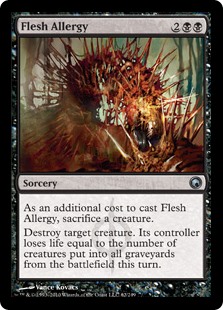
“I can’t wait for Doom Blade to be reprinted.”
-The dude-versus-removal tension lets NWO sets achieve strategic richness without overdoing on-board complexity. In fact, the “success” of recent formats is highly correlated with the amount of high-quality removal they offer. Jason Waddell has applied this idea to his Cube, lowering the concentration of sweepers and increasing that of spot removal. I believe M14’s principal design error was taking this idea too far, and forgetting to balance it with enough cards like Garruk’s Companion or Stormfront Pegasus.
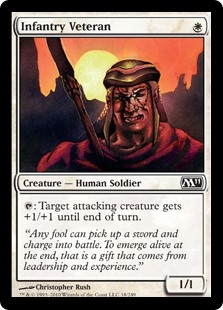
“After blockers, before damage …”
-The lack of activated abilities on creatures (like Gideon’s Lawkeeper) makes it hard to fight through stalls without the benefit of a removal spell, a bomb, or an aura.
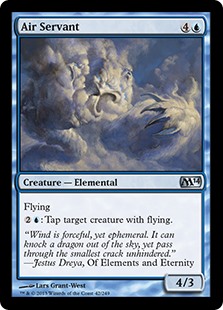
“How I learned to stop worrying …”
-So, in M14 — how to find your removal spells, bombs and auras? Draw cards — you have all the time in the world. Opportunity is a strong card in a vacuum, but in a set like M12 it wouldn’t have been that great. Yet here, it’s the best draft uncommon in the set by an enormous margin. Blue is often going to be very good in such formats, in the same way that it’s been the best color across Magic history — not because the creatures suck, but because the combat step is not as important as it ought to be. Cube designers, take note: though I’m a proponent of flattening the power curve for individual cards, it’s much more important to flatten the power curve of archetypes.
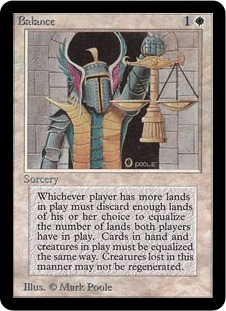
“Not the most self-descriptive card.”
Next week, we’ll look at the broader implications for environments with the same design flaws as M14.
Thanks for reading!
CML
@CMLisawesome on Twitter
Discuss this article in our forums.



